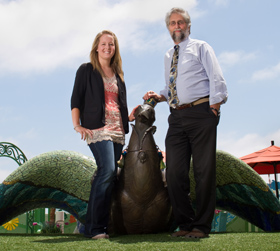By Diane Yohe

Dr. Mark Nespeca, director of the EEG lab at Rady Children’s and clinical professor of neurosciences at UC San Diego School of Medicine, put 5-year-old Hilary Hansen — now 19 — on the special ketogenic diet that eventually cured her epilepsy.
Hilary Hansen was 5 when she fell unconscious in her Coronado kindergarten class in October 1997.
Physicians at a local hospital thought she had low blood sugar and sent her home. When Hilary began having numerous seizures, however, her mother, Debbie, knew something was very wrong.
Debbie brought her daughter to the Sam S. and Rose Stein Emergency Care Center at Rady Children’s Hospital-San Diego. Hilary was hospitalized for a week and took several medications to try to stop the seizures. None of them worked. Hilary was experiencing six to 40 seizures a day, which would affect her head or her entire body.
Neurologist Mark Nespeca, M.D., director of the EEG (electroencephalogram) lab at Rady Children’s and clinical professor of neurosciences, the University of California, San Diego School of Medicine, put Hilary on an MCT (medium-chain triglyceride) ketogenic diet. A ketogenic diet is high in fat, low in carbohydrates and adequate in protein. The MCT ketogenic diet is 70 percent fat, 35 percent of which comes from a special MCT oil. Studies have shown the MCT diet to be effective in reducing seizures by lowering ketone levels. Ketones are substances made by the body when it breaks down fat for energy.
Patty Bell, a registered dietitian who worked at Rady Children’s, started Hilary on the diet. Hilary’s urine ketones had to be checked twice a day, and she needed periodic blood tests done in the lab for monitoring the diet therapy.
“Ketone levels had to be at 1 percent to prevent seizures,” Debbie said. “I had to weigh and measure everything that went into her mouth, and she had to eat everything on her plate for the diet to work.”
Debbie packed Hilary’s lunch, and a school employee sat next to her to make sure she ate every ounce of her food.
“I hated that diet,” said Hilary, now 19. “My mom put mayonnaise on everything and there was no sugar allowed. Mom was afraid to allow me to go to a friend’s house for a birthday party for fear I would eat cake.
My teachers were told I couldn’t have a cupcake at school parties so mom sent something from my diet. It was no fun for a 5-year-old kid.”
Hilary also had to take the MCT oil daily. Her mother dripped it on food and mixed it with Crystal Light.
Though sticking to this regimen was difficult, the results were remarkable. After just three weeks on the diet, Hilary was seizure-free.
“The goal of the diet is to eliminate seizures and hopefully wean children off epileptic drugs,” explained Vanessa Aldaz, a registered dietitian at Rady Children’s. “The hope is that the diet itself can control seizures and that eventually, children can come off the diet altogether and remain seizurefree.”
Hilary was one of these cases. “About six months after she started the diet, we tapered her off one of two anti-seizure medications she was taking,” Dr. Nespeca said. “The diet became a real challenge for Hilary, so we took her off of it in June of 2000, and she remained seizure-free. In the summer of 2001, she was totally off all medications. Hilary is an outstanding success story – the diet cured her epilepsy.”
Though it would have been much easier to take a pill than to weigh every ounce of food she gave her daughter, Debbie considers the diet to be a lifesaver. (Today, the diet is less restrictive, allowing for more protein and carbohydrates.) “Hilary would have had to stay on anti-seizure medications that weren’t working at all,” Debbie said.
Now a college student, Hilary has decided to pursue a degree in nursing. “Eventually, I hope to work with people who have epilepsy,” she said.
The San Diego Union-Tribune Kids’ NewsDay, October 2011